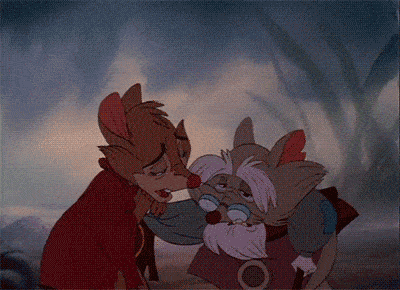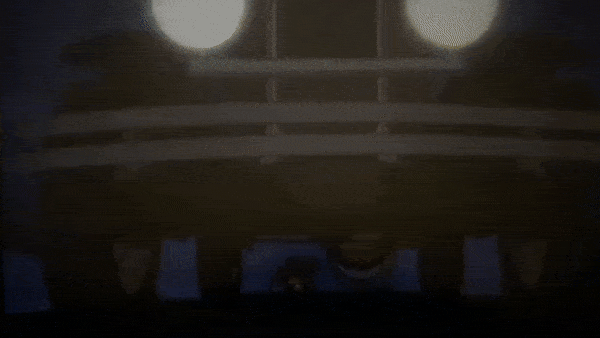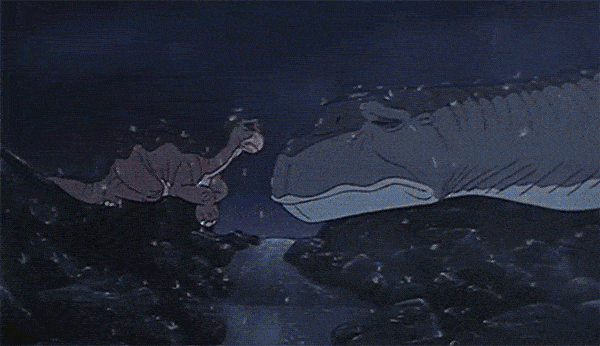The Melancholy of Don Bluth
How the children’s animation of the ’80s made room for sadness, and what that taught us.

There was a time when McDonald’s used to give away VHS tapes with happy meals, and by some stroke of luck, one day my mom picked The Land Before Time. It was the first film to etch itself onto me ‐ the way film tends to with kids. I would recreate the plot with stuffed animals and parrot the lines to whoever would listen; I pawed that VHS box until the cardboard went soft.
A couple of years ago, I saw that Land Before Time was playing on t.v. and couldn’t remember the last time I’d watched it all the way through. Within five minutes I was completely obliterated and sobbing into a throw pillow. This is a shared experience for children raised with Don Bluth: that as a kid, I could only clock a hazy sense that his films felt different from Disney fare, but that the articulations of this difference, and their ability to emotionally floor me, are something I’ve only become aware of in retrospect.
There was a regime change in animation during the ’80s. Quite literally in the form of Bluth’s official break with Disney in ’79, but in a more elusive sense with the landscape of what children’s animation during that decade felt like. For whatever reason, be it Bluth’s departure or a diseased managerial ethos in the wake of Walt’s passing, the ’80s were a mixed bag for Disney. Don’t get me wrong, they’re amiable and charming films, but The Fox and the Hound and The Great Mouse Detective are not classics. And for all its ambition, The Black Cauldron cannot be redeemed on technical merit. Disney would eventually yank itself out of its slump in ’89 with The Little Mermaid ‐ but animation during the ’80s, along with the childhoods of a slew of millennials, were definitively shaped by Bluth.
 That there is a dark tenor to Bluth’s work has been thoroughly noted — albeit perhaps vaguely — often citing individual moments of terror (cc: Sharptooth, you dick). While I don’t doubt that frightening and disturbing scenes contribute to an overall sense of darkness in Bluth’s work, I’m unconvinced that they’re at the root of what distinguishes his darker tone. There is, I think, a holistic sadness to Bluth films; a pervasive, and fully integrated melancholy that permeates his earlier work.
That there is a dark tenor to Bluth’s work has been thoroughly noted — albeit perhaps vaguely — often citing individual moments of terror (cc: Sharptooth, you dick). While I don’t doubt that frightening and disturbing scenes contribute to an overall sense of darkness in Bluth’s work, I’m unconvinced that they’re at the root of what distinguishes his darker tone. There is, I think, a holistic sadness to Bluth films; a pervasive, and fully integrated melancholy that permeates his earlier work.
These stories are full of crystalline moments of narrative sadness; specific story moments at which I inevitably mutter a “fuck you, Don Bluth,” and try not to cry. There’s Littlefoot mistaking his own shadow for his dead mother; Fievel sobbing in the rain (a Bluth mainstay) convinced that his family has abandoned him; Mrs. Brisby shuddering helplessly after she and the Shrew temporarily disarm the plow. Other plot points are less tear-jerking so much as objectively miserable: the cruelty of the humans in The Secret of NIMH; An American Tail’s intelligent allegory for Russian Jewish pogroms and immigration; Carface getting Charlie B. Barkin drunk and murdering him at the pier.

Thematically, there is an ever-present air of death about Bluth’s work that is profoundly sad. Bones litter certain set-pieces; illness and age are veritable threats (shout out to Nicodemus’ gnarly skeleton hands); and characters can and do bleed. Critically, Bluth films don’t gloss over grief, they sit with it. From Littlefoot’s straight up depression following the on-screen death of his mom, to Mrs. Brisby’s soft sorrow at finding out the details of her husband’s death. There is a space for mourning in Bluth’s stories that feels extra-narrative, and unpretentious. Critically, this is distinct from, say, wallowing. Bluth’s films have a ridiculously productive attitude towards mourning, most lucidly articulated through Land Before Time’s moral mouthpiece Rooter: “you’ll always miss her, but she’ll always be with you as long as you remember the things she taught you.” Disney meanwhile, tends to treat death as a narrative flourish, or worse, a footnote. And in comparison, even notable exceptions like Bambi and The Lion King seem immaturely timid to let palpable grief linger for longer than a scene, let alone throughout a film’s runtime.

Musically, James Horner and Jerry Goldsmith’s impossibly beautiful scores are laced with a forlorn undercurrent. In particular, Horner’s tonal dissonance in The Land Before Time theme punches the Wagner-lover in me in the throat (admittedly, a good thing). Further to this, the first half of Goldsmith’s “Escape from N.I.M.H,” is reminiscently Tristan and Isolde-y. And while I’m here, I would also like to formally issue a “fuck you for making me cry in public” to American Tail’s “The Great Fire,” which when combined with visuals, is nothing short of devastating.
Speaking of visuals, backdrops of grim and vast indifference dot Bluth’s work; from the twisted Giger-esque caverns of the rats’ rosebush, to the urban rot of a thoroughly unglamorous New York and New Orleans. That these landscapes are in a state of decay is particularly dismal; there is a tangible barrenness, a lack of the warmth our characters are desperately hoping to find by their film’s end. These are depressed and morose spaces ‐ and that they are so seemingly unnavigable and foreboding makes them all the more compelling, and narratively resonant.

The way Bluth uses color is also notable, with dark, earthy tones prevailing throughout only to be blown out quite literally with the golden light characteristic of Bluth’s hard-earned happy endings. Before Littlefoot and friends reach The Great Valley, an event marked by gradually illuminating god-rays, they must slug it out through the parched browns, blues and pitch of their prehistoric hellscape. Like Charlie’s final ascendance into heaven, Fievel must endure similarly muted shades until he is finally (finally) reunited with his family and soaked in glitter ‐ a level of Don Bluth conclusion-sparkles perhaps only rivaled by the radiance of Mrs. Brisby’s amulet as she Jean Grey’s her homestead to safety at the end of NIMH. Because Bluth leans into darker, less saturated tones, these effervescent conclusions are all the more impactful, which speaks in part to the methodology of Bluth’s melancholy.
The plucky leads of Bluth’s early films are all fighting for the same thing: family. From Mrs. Brisby’s persistence to protect her children to Charlie’s (eventually) selfless love for Anne-Marie, these are characters in search of a home. Invariably, each of these characters gets their happy ending, but they have to go through hell to get there, literally in Charlie’s case. In a recent interview, critic Doug Walker asked Bluth if there was any truth to the rumor that he thinks you can show children anything so long as there’s a happy ending, to which Bluth replied:
[If] you don’t show the darkness, you don’t appreciate the light. If it weren’t for December no one would appreciate May. It’s just important that you see both sides of that. As far as a happy ending…when you walk out of the theatre there’s [got to be] something that you have that you get to take home. What did it teach me? Am I a better person for having watched it?
Melancholy isn’t just a narrative device for Bluth, it’s a natural part of navigating life, of searching for wholeness, and becoming a better person. Bluth acknowledges sadness in a way that never diminishes or minimizes its existence; he invites melancholy in, confesses its power, and lets it rest. Sadness is, for Bluth, an essential characteristic of the world and living in it. That is a wholly edifying message for kids, delivered in a vessel that is both palatable and unpatronizing. For this reason, among innumerable others, Bluth’s work has immense value as children’s entertainment…even if it means crying into a throw pillow twenty years later.
